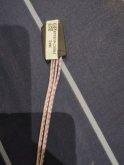Yep, exactly 
It's actually 0.0235 %, 2 k would be 0.2 %; also that's assuming the input impedance is 1 M which can be totally off depending on the BMS we talk about. The nice thing is that it's a linear error so if you calibrate for it then it should stay calibrated for all the current values.
If you want to eliminate almost all error then you can use an active filter, but you really need to know what you're doing when you chose the op-amp as we're working with very low level signals, things like Vos can ruin the accuracy if they're too high.
It's actually 0.0235 %, 2 k would be 0.2 %; also that's assuming the input impedance is 1 M which can be totally off depending on the BMS we talk about. The nice thing is that it's a linear error so if you calibrate for it then it should stay calibrated for all the current values.
If you want to eliminate almost all error then you can use an active filter, but you really need to know what you're doing when you chose the op-amp as we're working with very low level signals, things like Vos can ruin the accuracy if they're too high.





